
I got inspired by The Spellbook of Katrina Van Tassell ( A | BN | K | G | AB ) and went looking for a Dutch recipe that was very seasonal and tasty and also used the oven because IT GOT CHILLY HERE, and that was from the general era and might have been something that Katrina would have eaten. This was made much easier by a friend of mine who is a living history nerd (much like myself) and also a Dutch American who is incredibly proud and knowledgeable of his family history. So when I said “Ian, do you know of a Dutch American colonial era cookbook?” he had The Sensible Cook off the top of his head.
My friends are the BEST.
The Sensible Cook (De Verstandige Kock) is, according to its preface, “…really the only Dutch cookbook of the 17th century.” It’s part of larger household manual called The Pleasurable Country Life, and the edition I have was translated from a 1683 edition which belonged to a Dutch family who emigrated to New Netherland in the 1630s, and lived in the area until the 1940s. It is not a stretch to imagine that these recipes would have been known to people in the post-Revolutionary War era.
I mean, it’s apple pie.
There are several recipes for taerts of various kinds, and four apple taerts. I went with the one in the Walloon manner because…well, it involved cooking the apples in wine, and that sounded fun. As a note, there’s a couple of major ingredient substitutions due to availability of either the ingredient or the dollars to buy the ingredient.
To make an Apple Taert in the Walloon manner
Take peeled Apples with the cores removed, boil them in Rhenish wine until well done, add butter to them, Ginger, Sugar, Currant, Cinnamon cooked all together very well, then stir the yolks of 2 Eggs, place [the mixture] in your Dough and bake in the Oven as mentioned before.
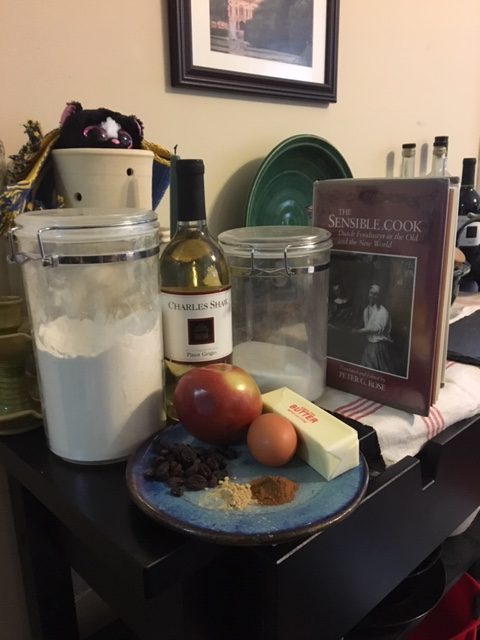
It’s basically “applesauce as pie filling.” “The Walloon manner” refers to the French speaking region of southern Belgium, Wallonia.
One of the delights of my adulthood is learning that there are a wondrous variety of apples. I picked Empire apples because it’s variety that developed in New York, at Cornell University. Yes, it was in the 20th century, but I liked the symbolism and also they were on sale.
Rhenish wine was also a fun little conundrum, and had I not had the pinot grigio on hand already, I would have gotten some German riesling (I love riesling). But I did have grigio on hand. Also, the grocery store was out of currants, which was an appalling state of affairs, so I got raisins instead.
First, peel and core the apples (I had five or six), put them in a pot with half a bottle of wine to cook down.
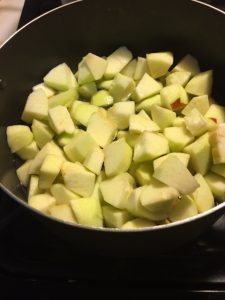
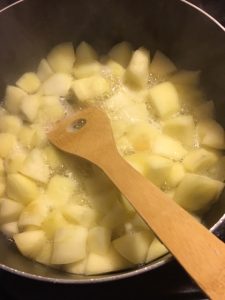
Once they were nice and mushy, I put in a half stick of butter (what was left over from making the dough) and a tablespoon or so of cinnamon and ginger. Also a quarter cup of sugar, and 4 ounces of raisins (okay, I ate some raisins. 3.7 ounces).
I let that cook for another ten minutes or so, then let it cool down before adding the egg yolks.
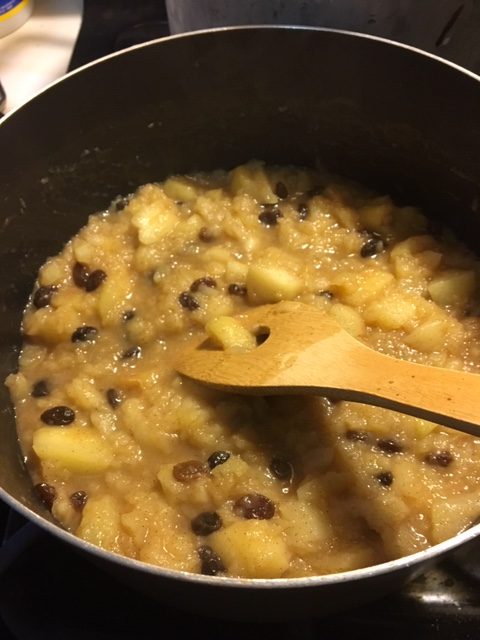
I wanted to let it cool before adding the yolks because I didn’t want them to cook before I got the whole mess into the oven. Also I needed to make the dough.
I used the dough from another apple taert recipe – you’ll note that the Walloon style doesn’t specify a dough.
Take a pond [pound] of flour, 4 spoons water with 2 or 3 spoons sugar, this [water and sugar] cooked together in a syrup, add to it an Egg, furthermore as much butter as is needed to make a suitable Dough, this gives a good crust.
So I realized that working from historic cookbooks is like an endless Great British Bake Off technical challenge: there’s only the sketch of instructions, but Paul Hollywood can’t tell me I’m wrong. Also, I’m not a great baker. I’m merely competent because I follow directions. This crust would have been better if I was better at pie crust and had a better understanding of what ratios work the best (but that egg throws in a curve ball).
So I had two cups (ish) of flour, and a stick and a half of cold butter crumbled in (I don’t use a pastry cutter or two knives, I just use my clean fingers). I made a simple syrup of 8 tablespoons of water and 6 tablespoons of sugar, and one egg. Because the syrup was hot when I put it in, the butter was kinda melty, and I overworked the dough. I put in the fridge to rest and cool down (so it would roll out) which WAS a good call, but the end result crust was chewy and I don’t think it was down to just the egg.
I need to get better at pie crust, but that would be easier if I actually liked dessert pie.
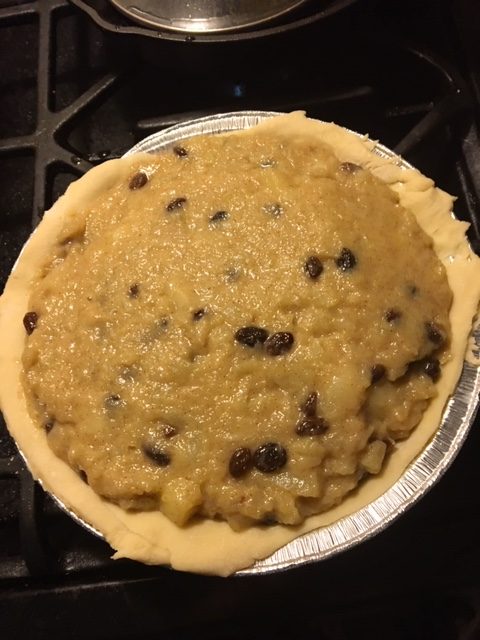
Anyway, crust in the pie tin, filling in the pie crust, and in it goes into the oven. I am a big fan of “when in doubt, set it at 350.” It took it out after about 30 minutes or so, and honestly, it could have gone for another ten minutes or so. The center was still a bit loose and yes, the bottom was kinda soggy.
But! It was tasty! It’s a thick applesauce with raisins, and were I to make this again, it would be without the raisins. The currants would have been an improvement: the smaller size would have been less annoying as a textural element. I had some guinea pigs (not actual guinea pigs) over to try it, and they liked it! It’s tasty and fun and makes your house smell delicious.
But mostly I learned that wine as the base for an applesauce is DELICIOUS and I wholly support it.


I love these entries and your substtutions !! I live overseas. I haven’t had the correct Ingredient list to anything in 2 years.. Your recipes reproductions are informative and make me laugh ! Thanks for that
Everything about this looks amazing. Also I bet you picked the Walloon recipe because half of all Swedes claim to be Walloon descendants. =D Also Walloon is really fun to say.
I love this. I am fascinated by historical recipes and cooking and preservation methods. A really fun read. Also, if you’re interested in baking more with pretty loose instructions, you might want to check out the cookbook Ratio by Michael Ruhlman. It is filled with baking ratios (like 3 parts flour 1 part sugar and 2 parts fat for basic cookies) and is fun for playing around in the kitchen.
This looks yummy! I have currants in the cupboard and have to check our favorite farm stand tomorrow for some heirloom apples.
Thanks for a fun post, RedHeadedGirl. I have a recipe for an apple tart given to me by a Dutch friend. It’s quite different from yours but also delicious.
By my usual conversions, two cups of flour would be slightly more than half as much as the recipe called for (1 cup = 125 grams = 4.4 ounces). Did you weigh it, or measure by volume? Or was the actual pound measurement different in the time/location where the recipe book was published? Because that could have seriously affected the crust.
I want to see the tart after it came out of the oven!
Does the filling end up set? It does sound good apart from the raisins *spit*
The chewy pastry is definitely not down to the egg. I know this because of my weird dad, after my mum died my dad had to learn to look after himself, everything from paying the bills to cooking, my mum had taken care of all of it for the forty years of their marriage. Dad certainly hadn’t learnt how to cook before they married. Because he was like that, he decided to learn to cook by working it out for himself rather than oh say picking up one of my mum’s cookery books. He did surprisingly well or perhaps more likely he only shared his successes with me, anyway one of his outstanding successes was pastry. He made this by using half fat to flour by weight, rubbing in the fat then using an half an egg for the liquid and the rest for brushing the top of the pie. It produced a very tasty crumbly pastry that he used to top both savoury and sweet pies.
My guess is the chewy nature of the pastry was because you handled it too much. Pastry should be handled as little as possible, ideally rub in, bring together with as little cold water as possible, chil, roll out, chill again, fill and cook. Putting a cookie tray into the oven as it heats then utting the pie on top of it will help a bit with soggy bottoms.
I have used an egg in pie crust (usually for savory pies, like Aunt Sue’s Ham Pie) and I think part of the issue may have been the order in which you added the ingredients; I would have put the egg directly into the flour/butter mixture and blended that before adding the simple syrup and however much cold water was needed after that. Not saying that’s correct according to your recipe, but just the way I’ve done similar in the past.
I would never have thought of adding wine to an apple pie, but I have poached pears in wine, so it adds up. I’ll have to try that.
A suggestion for crumbling cold butter: put your butter in the freezer, then use a cheese grater to grate it into the dough mixture. It comes out in small, thin strips, so you end up handling it less (a VERY GOOD thing for pie crust).